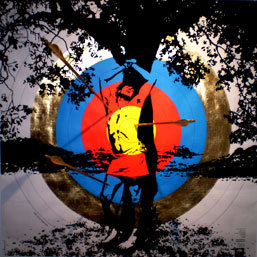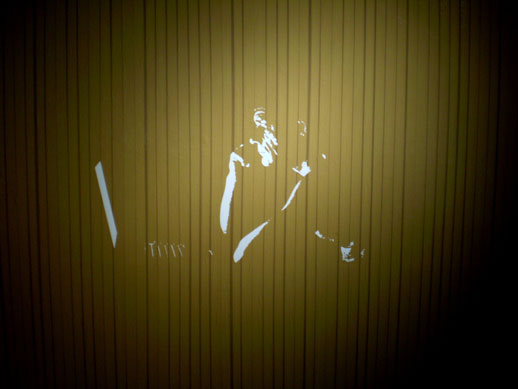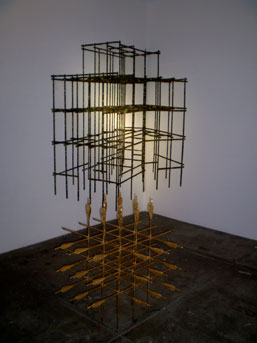Behold the Man
The image of Saint Sebastian is easy recognizable on vintage tees from tucked-away art shops, pro-peace stickers and occasional inner-city graffiti scrawl. In pop vernacular he’s been described as an icon, a beacon of hope for the oppressed, particularly the gay community. Images of the Saint — hanging by ropes around his wrists as he is about to be shot — are deceptive. Even though he is about to die, he seems to be in the throes of ecstasy. As the target, his image projects an inner calm and subtle eroticism that creates a duality between his former circumstances and our perceptions of it.
Robert Waters exhibition “Man” is a series of images with double messages, along the lines of nature versus nurture, or in this case violence versus healing. The first exhibit hit me unawares as I entered the gallery. Two television screens, no more than fifteen feet apart, face each other from the opposite ends of a long, dark hallway. In the middle of my walk through this hallway, a loud POP! sound echoes from one of the screens, slightly startling me. On the screen directly facing me I see a man loading a weapon. I turn to look at the second screen and notice a target. I smile, as I feel the intended effect of this setup. Synchronized between two television sets, Waters’s first exhibit ‘Learning to Care/Learning not to care’ quickly reveals two statements in on fell swoop. Though the men in the video are loading rifles and shooting at a target, the target is only being hit at points on the body that acupuncturists use to heal people. A weapon traditionally is meant to maim or kill. These men are healing with each shot they make.
 ‘Killing Saint Sebastian’, the next exhibit, is similar. The image of Saint Sebastian’s execution is colorfully depicted in this image, with the tree he was hung from a stark black color, recreated with meticulously cut adhesive black velvet. Several gold arrows are sticking directly into his body, but the image doesn’t feel morbid, but celebratory. Vibrant hues, even the gold arrows make the Saint seem happy and without remorse.
‘Killing Saint Sebastian’, the next exhibit, is similar. The image of Saint Sebastian’s execution is colorfully depicted in this image, with the tree he was hung from a stark black color, recreated with meticulously cut adhesive black velvet. Several gold arrows are sticking directly into his body, but the image doesn’t feel morbid, but celebratory. Vibrant hues, even the gold arrows make the Saint seem happy and without remorse.
A companion piece ‘The Ecstasy of Saint Sebastian’ is an evolved version of ‘Killing Saint Sebastian’. Waters continues his idea of being a target by emblazoning a canvas with the faces of men all in moments of ecstasy, each person with the classic red circles of a target over their faces. Every face in the image is taken from still frames of adult movies, with the exception of Diego Maradona and Lionel Messi, who make guest appearances on this work, mostly likely taken from celebratory moments after scoring fabulous goals. George Bataille talks of a moment of ecstasy being similar to a “little death”, and this is what this image is: several men all having little deaths, while being targeted; juxtaposing a heightened moment of vulnerability with a sense of fear.
The next piece falls more into the realm of the voyeuristic. ‘Clean up your act you dirty Faggots!’ looks taken directly from the room of a shy young man who kept nude pictures of men above his desk. Placed on a white canvas above the little desk and chair gives them a youthful feel. Each picture is quite aged, as they were originally from the Seventies. As time passes and conventions and attitudes towards homosexuality change and fade, the pictures fade as well.

The behemoth of the exhibit, ‘Man At Computer’, feels momentous. I feel this image is Waters’s most powerful and thought-provoking. The image of a man at a computer, his face revealed by the tell-tell silhouette of a computer monitor’s dim light, screams isolation and anti-sociality. It speaks tomes about our modern society and its shift from regular physical communication to distant, mostly anonymous interaction. What is interesting about this image is we have no idea what the man at the computer is looking at. It could be news, pornography, video games or an ebook, but we know without a doubt the man is completely alone. The image — spread out over the expanse of a large wall — can’t help but make one ask if this exhibit isn’t just a depiction of an aspect of our current sociological minutiae but a portentous look into the future.
 ‘Are you a body or do you have a body?’ is a fascinating question mark in artistic form. Twin images of a weight machine on black and white canvases create an overtly archaic feel to an easily recognizable modern-day machine. Surgical tape is used quite cleverly as the “paint” for this image, giving it a more tactile message, which directly relates to modern man’s obsession with the body, and by extension, beauty.
‘Are you a body or do you have a body?’ is a fascinating question mark in artistic form. Twin images of a weight machine on black and white canvases create an overtly archaic feel to an easily recognizable modern-day machine. Surgical tape is used quite cleverly as the “paint” for this image, giving it a more tactile message, which directly relates to modern man’s obsession with the body, and by extension, beauty.
At a low angle, the last exhibit ‘Jungle Gym’, with its digital-camouflage fabric pasted on the wall in the far left corner of the gallery, resembles the evil shadow of a delicately painted set of golden bows moulded to look like a classic jungle gym. Here Waters continues to hit us with double meanings in his work. Classically the jungle gym is a fixture of our childhood, a place we learn the ups and downs of social interactions. In the jungle gym, we play, discover pain from little accidents and learn many basic aspects of ego and self-esteem. In some ways that early time period resembles the exhibit. If I had played in a jungle gym with sharp arrow tips instead of smooth bars, that blissful period might have been quite different.
In life we are always at the ready, our behaviour and responses to our daily stimuli like little arrows hidden in an invisible quiver slung on our backs. Historically men have never moved forward without revolution, death and destruction. Let us hope that future questions about mankind can continue to be asked in forums like these; through pictures and props, rather than in the real world, where pain isn’t just an idea, but a reality.
Marcus Bird
Marcus Bird


